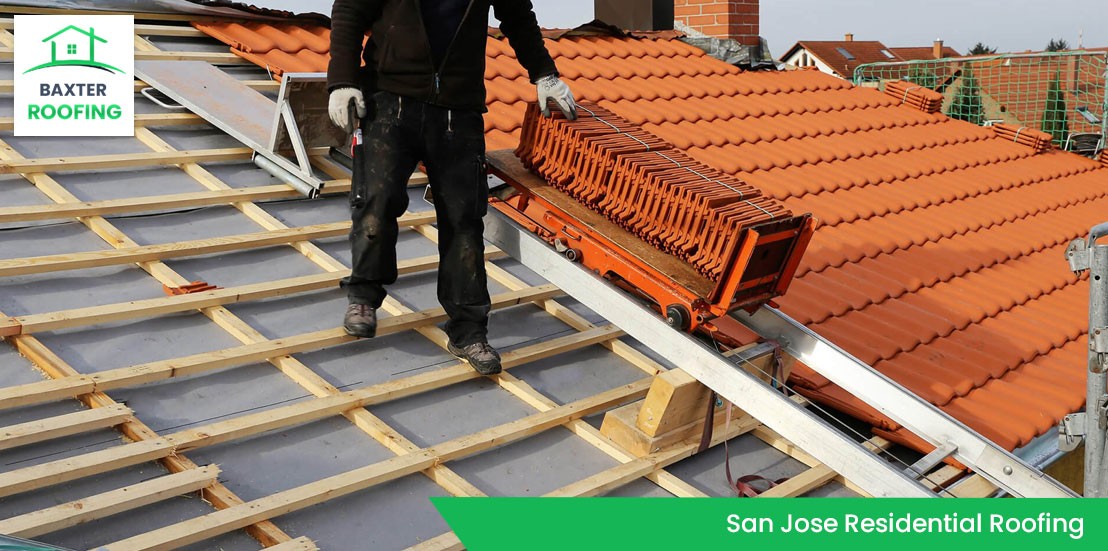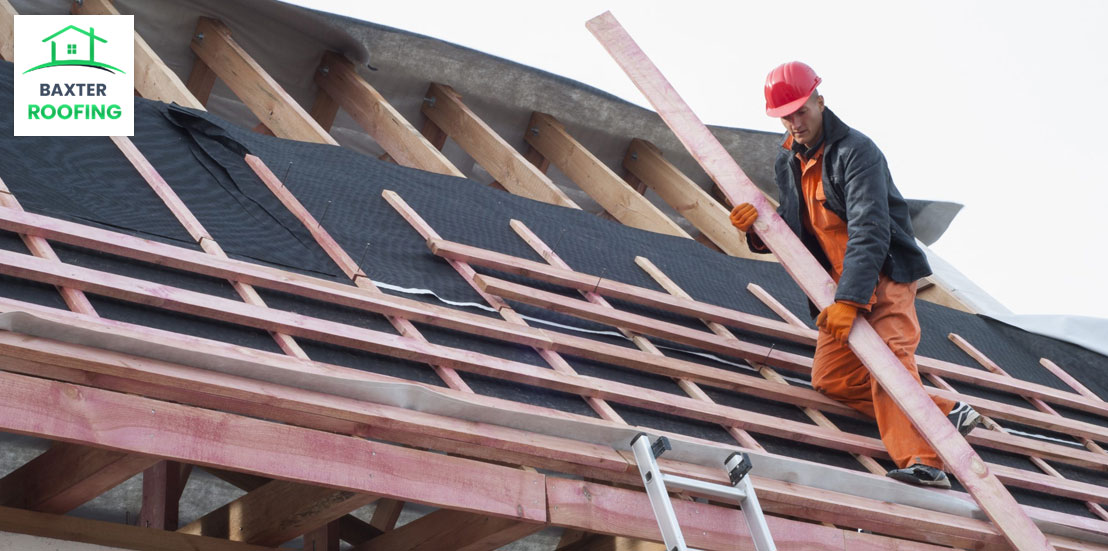Common Residential Roofing Challenges in the San Jose
The San Jose climate can pose some unique challenges to your roof. With thousands of local roofs serviced over the years, Baxter Roofing contractors have discovered some patterns of common issues in the San Jose area, including:
- Skylight Leaks – The seals around skylights often begin to fail 5-10 years after installation, allowing water intrusion.
- Premature Shingle Damage – Large temperature swings combined with wet weather causes shingles to crack, lift up and granule loss faster than expected.
- Excessive Moss Growth – San Jose’s damp, moderate climate encourages thick moss accumulation which retains moisture and can lead to rot.
If you notice any of these roof problems, trust Baxter Roofing to diagnose the issue and recommend the right solution. Call or contact us online to schedule an inspection.

Choosing the Best Roofing Materials for Your Home
San Jose’s climate experiences hot, dry summers and heavy winter rains, making it essential to choose the right roofing materials that can withstand these conditions over decades. At Baxter Roofing, we have extensive experience with different roofing materials suitable for standing up to these conditions:
- Asphalt Shingles – A versatile and affordable option available in a wide variety of durability ratings, colors and architectural styles.
- Concrete Tile – For a beautiful, Spanish-style aesthetic that is extremely durable. Heavyweight tiles resist even heavy winds when installed properly.
- Metal Roofing – A long-lasting option (50+ years) with excellent rain runoff and solar reflectivity. Though more costly upfront, it is very low maintenance.
Every home roof has unique needs and budgets. During your free estimate from Baxter Roofing, we’ll evaluate which materials make the most sense for your property to deliver maximum value and performance.
Our Residential Roofing Services
Let’s provides an overview of our full range of San Jose residential roofing services:
Residential Roof Installation
Quality roofing is essential to protect your most valuable asset—your home. When it comes to protecting your home, the roof plays a crucial role. It shields you from the elements and ensures your peace of mind. A well-installed roof not only enhances the curb appeal of your home but also adds value to your property.
Steps Involved in Residential Roof Installation
When it comes to residential roof installation, Baxter Roofing follows a meticulous process to ensure quality and durability.
- Initial Inspection – Thorough inspection of existing roof to identify underlying issues.
- Preparation – Removing old materials, repairing damages, ensuring sound structure.
- Installation of Underlayment – Installing protective barrier between roof and structure.
- Roofing Material Installation – Precise installation of chosen material for watertight seal.
- Flashing and Sealing – Proper flashing around protrusions to prevent leaks.
- Final Inspection – Final check that installation meets high standards.
By following these steps diligently, Baxter Roofing ensures that every residential roof installation project is completed with precision and care.
Materials Used for Residential Roof Installation
When it comes to choosing the right materials for residential roof installation, Baxter Roofing prioritizes quality and durability to ensure customer satisfaction.
| Material Type | Composition/Types | Key Benefits/Advantages | Durability/Longevity |
| Asphalt Shingles | Made from a blend of asphalt and fiberglass or organic materials. | Affordable, versatile, available in a wide range of colors and styles. | Can last 15-30 years depending on the quality. |
| Metal Roofing | Includes options like steel, aluminum, and copper. | Longevity, energy efficiency, low maintenance. | Can last 40-70 years or more with proper care. |
| Clay or Concrete Tiles | Molded from clay (baked at high temperatures) or concrete materials. | Fire-resistant, durable, environmentally friendly. | Can last 50 years or more when well-maintained. |
| Wood Shingles or Shake | Typically made from cedar, redwood, or pine. | Natural and rustic appearance, aesthetic appeal. | Requires regular upkeep to prevent rot and mold. |
| Synthetic Roofing Materials | Includes synthetic slate, rubber roofing, and composite materials. | Lightweight, eco-friendly, often recyclable. | Varies depending on the specific material chose |
By offering a diverse selection of high-quality roofing materials, Baxter Roofing ensures that each homeowner can find the perfect option to enhance both the aesthetics and functionality of their roof.
Residential Roof Repair
Roof damage is more common than most homeowners realize. According to the National Roofing Contractors Association, over 70% of homes suffer from roof wear and tear by year 15 of the roof’s lifespan. As a leading provider of roof repairs, Baxter Roofing understands how vital rooftop maintenance is for every home.
Our Roof Repair Process
Our comprehensive roof repair process comprises industry best practices to deliver reliable, long-lasting solutions home and business owners can count on.
Inspection
The first step is a 30-60 minute visual assessment by an experienced Baxter technician. Every inch of the roof structure is examined at close range for deficiencies. You’ll receive a detailed inspection report summarizing our findings.
Diagnosis & Repair Recommendation
Next, we analyze what’s needed to remedy roof defects based on inspector insights, your repair goals and budget, warranty stipulations, etc. We’ll provide a computer-generated quote detailing repair specifications, materials, projected timeframe and more.
Initiating Work
Once you approve the plan, we take care of pulling local permits if required before scheduling work crews. We strive to commence most jobs within 2 weeks of initial inspection. Emergency leak response can begin next business day.
Repair Process
Baxter Roofing uses quality GAF materials installed per manufacturer instructions. You can expect a neatly run project with drop cloths, magnetized shoes on metal roofs, restricted dumpster access, and daily site cleanup.
Inspection & Further Repairs
Post-project, a manager double checks all completed repairs, troubleshoots any subsequent issues if rainscreen tests show leaks, and ensures you’re 100% satisfied with the end result before we close out.
Residential Roof Replacement
Roof replacement is one of the most critical home improvement projects a homeowner can undertake. According to industry data, the average asphalt shingle roof lasts just 20-25 years before needing full replacement. With over 48 million homes over 30 years old in the U.S. alone, a massive number of residential roofs are operating well past their expected lifespans and are likely in urgent need of roof replacement.
Knowing When It’s Time for Roof Replacement
Determining precisely when an aging roof has reached the end of its lifespan and requires full replacement can be challenging. Baxter Roofing trains its roofers to spot several critical warning signs that indicate a roof is no longer effectively protecting the home:
Warning Signs
- Numerous missing, cracked, curled or broken shingles
- Leaks noticeable inside attic after rain/snow storms
- Dark streaks on roof deck from water infiltration
- Sagging roof structure or areas of poor drainage
- Excess roofing granules in gutters
Risks of Waiting
Putting off a needed roof replacement allows additional water damage, decay and mold to impact home. Leaks can lead to very costly repairs if left unattended. Postponing replacement also exposes home & contents to break-in if damage is severe.
Evaluation
Baxter Roofing provides comprehensive, Obligation-Free evaluations. Our certified roof inspectors examine roof age, condition, structure, ventilation and insulation. Homeowners are given re-roofing recommendations best suited for their home & budget.
Roof Age & Homeowner Needs
If a roof is over 20 years old, replacement often makes sense even if other damage is not visible yet. Home additions or renovations may also require updated roofing to match. We help homeowners determine if roof has exceeded expected lifespan & requires full replacement according to their coverage needs & goals.

Roof Replacement Process Step-By-Step
When Baxter Roofing undertakes a complete tear-off and roof system replacement, we follow meticulous protocols and construction processes:
| Step | Description |
| Tear-Off | All existing roof materials are removed down to the roof decking, ensuring a clean slate for inspection. |
| Damage Inspection | Post-tear-off, certified technicians inspect for water damage, dry rot, and structural issues with the roof deck, repairing any damage found. |
| Underlayment | Installation of updated non-combustible decking, leak barriers, drip edge flashing, and roofing felt or synthetic underlayment. |
| Careful Installation | New architectural or 3-tab shingles are installed following manufacturer guidelines to ensure code compliance, using professional grade nails and installation standards. |
| Flashing & Ventilation | Re-flashing of all roof penetrations. Installation of new attic ventilation to promote airflow and prevent moisture and heat buildup. |
| Site Clean Up | Meticulous site cleanup is conducted. Roofing debris is removed using magnetic sweepers and tarp protections, and parts of landscaping affected by the removal are restored. |
Residential Roof Inspection
So, you’ve found yourself wondering about the state of your roof. Well, you’re in the right place! Roof inspections are like a health check-up for your house. Just like you’d visit a doctor for a routine check-up, your roof also needs regular assessments to ensure it’s in top shape.
Inspect Your Roof For Warning Signs
When it comes to maintaining the integrity of your home, paying attention to signs of roof damage is crucial. Here are some common indicators that may signal potential issues with your roof:
Visual Inspection:
- Missing or Damaged Shingles: Keep an eye out for shingles that are cracked, curling, or completely missing. Even one missing shingle can lead to leaks.
- Sagging Roof: If you notice any areas where the roof appears to be sagging, it could indicate a structural problem or rotting wood underneath.
- Exposed Nails: Nails that are visible could mean shingles have been lifted by weather, leaving nails exposed and prone to rust.
- Water Stains on Ceilings: Discoloration on your ceilings could be a sign of water leakage from the roof. Don’t ignore stains!
From Inside the Home:
- Leakage: Water dripping from the ceiling during rainfall is a clear indication of a roofing issue. Look for dripping water after storms.
- Mold or Mildew: Presence of mold or mildew in the attic could be due to moisture seeping in through the roof. Be on high alert for mold.
- Daylight Through Attic: If you see daylight seeping through roof boards, it likely means shingles or other roof materials are damaged.
Exterior Examination:
- Gutters Filled with Granules: If you find granules from shingles accumulating in your gutters, it might indicate shingle deterioration.
- Flashing Damage: Check for any damaged flashing around chimneys, vents, and skylights. Flashing helps prevent leaks.
- Roof Debris: Examine your roof after storms and look for any accumulated debris like branches or leaves. Remove debris to prevent damage.
Regularly inspecting your roof for these warning signs can help you catch problems early on and prevent costly repairs down the line. Don’t wait until it’s too late!
FAQs
For San Jose’s hot summers and rainy winters, durable asphalt shingles, concrete tile, and metal roofing withstand the fluctuations well and are local roofers’ top recommendations.
Homeowners should have their roof professionally inspected every 1-2 years to catch minor damage early. Roofs over 10-15 years old or experiencing extreme weather should be examined annually.
Signs like missing, cracked or curling shingles, leaks inside the home after storms, dark attic roof deck streaks indicating water damage, and sagging roof sections mean prompt contractor repairs are needed.
A full roof replacement involves tear-off of old materials, inspection and repairs to the roof deck, installation of protective underlayments, careful installation of new shingles/metal panels/tiles, proper flashing around penetrations, and cleanup.
